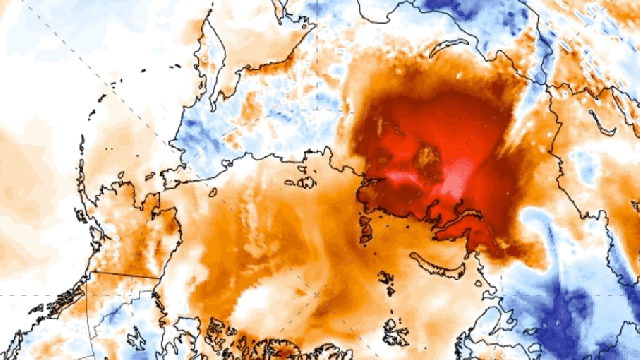This story will provide important context for the headline, and I encourage you to read it—but really, the headline tells you what you need to know: It was 26 degrees Celsius above the Arctic Circle this week.
A little farther south, in Siberia—you know, the region of world we reference when we want to connote something cold—it was 30 degrees Celsius. Arctic sea ice in the neighbouring Kara Sea took the deepest May nose dive ever recorded. Oh, and random swaths of the region are on fire. Things are extremely wrong.
Let’s start with the heat above Arctic Circle. Mika Rantanen, a researcher at the Finnish Meteorological Institute, flagged a map showing blistering heat across western Siberia. The region has been the epicentre of an explosive heat wave that has rippled across the Arctic this week. Models forecast temperatures there will be as much as 30 degrees Celsius above normal for this time of year. The heat could break a bit by the middle of next week, but widespread warmth will continue to grip the region.
Quite remarkable temperatures in western Siberia today.
For example 26.4°C as north as Arctic Circle (66.6°N) and 30.1°C at 62.5°N. pic.twitter.com/nH5TDipUMk
— Mika Rantanen (@mikarantane) May 21, 2020
On land, it means wildfires continue to spread. Pierre Markuse, a satellite monitoring expert, has kept an eye on the series of increasingly odd fires above the Arctic Circle, a place known more for ice than fire. Most of the blazes he’s documented are in the eastern portion of Siberia, which also dealt with its fair share of heat all year in addition to low snowpack. Seeing fires burn next to braided rivers and large patches of unmelted snow is truly a mood for our current era of climate destabilization.
Then there are the ocean impacts, because climate change doesn’t just stop at the water’s edge. Warmth has washed over the seas that border Siberia, and the Kara Sea north of the western part of the region has seen the most precipitous decline in sea ice. After a slow decline in the first part of May, warm air has fuelled a stark decline in sea ice. As of earlier this week, ice extent was the lowest level that’s ever been record in May. It stands as a stark outlier, especially when looking at how ice behaved in the 1980s. I’m old enough to remember when the ice in the Kara Sea used to decline in July.
Numerous other seas that ring the Arctic have also been losing ice. And while they’re not at record-setting levels like the Kara Sea, the Bering and Barents Seas are both at some of their lowest levels on record for this time of year.
Striking to compare the timing differences in the start of the summer melt season in the Kara Sea – for instance, look at 2020 (red line) relative to the 1980s (purple lines) pic.twitter.com/9XkWTLONZQ
— Zack Labe (@ZLabe) May 20, 2020
These impacts are the latest in a litany of climate horrors for the Arctic as a whole. Last summer, it reached 2017. And you get the point.
I have to be honest. I’m getting sick of writing these stories. The Arctic is warming twice as fast as the rest of the globe, and what’s happening there is unprecedented. But how many ways can you talk about the fact that the Arctic is just extremely, massively fucked by climate change when the impacts are relentless? After a while, the degrees above normal start to feel normal, and the records are ephemeral, set to broken again the next year.
But here we are with just another absolutely outlandish occurrence. I’ll keep writing about them, because even if the records start to blend together, that in itself is a sign we really need to get our shit together and cut emissions now.
